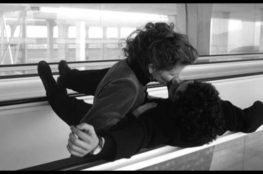
Jean-Pierre Melville’s Le Samouraï has to be one of the coolest movies ever made. Just the production details offer a foretaste of its coolness: anything made in France in 1967 starring Alain Delon should at least pique a movie buff’s interest. Le Samouraï blends 40’s American gangster movie aesthetics, 60’s French pop culture and a dash of Samurai mystique.
Delon plays Jef Costello – a meticulous and solitary hitman – with a captivating degree of detatchment and sang-froid. Like Kyuzo in Seven Samurai he never speaks without good reason, never moves unless he has to. When Jef steals a car he stares impassively into the middle distance as he slots key after key from a large ring into the ignition of a Citroën DS. His eyes are a cold metallic blue.

Other elements of his dress and makeup are at once an adaptation and combination of the look of the samurai and the 40’s American gangster. When Jef stuffs a revolver into the pocket of his overcoat, the cut of the garment and the way he moves is reminiscent of Toshiro Mifune tucking objects inside his kimoto in Yojimbo. Mifune’s face is suggested in the shape of Delon’s eyebrows, and Delon’s voice is almost an echo of Mifune’s: lots of bass and a clipped economical delivery.

Melville’s writing and direction take the aesthetic of the movie towards the formalist and minimalist. There is almost no dialogue for the opening ten minutes of the movie at least, only the sounds of Paris and the chirping of Jef’s pet bird in its cage in the middle of his room.


The violence in the movie is very stylised, and the two killings Jef carries out are shot in an almost identical manner with identical odd cutting rhythms. Every time Jef (and apparently any killer in a Melville movie) is about to commit a murder he puts on thin white film editor’s gloves. Within the mise-en-scene these prevent him leaving fingerprints, but metaphorical level they signify him editing someone out of the movie. In this way Melville creates a visual association between the perfectionist protagonist and himself.

As the movie was mostly shot on location it also forms a great document of Paris in the late 60’s. The métro, the cars, the posters on the streets, the clothes, the hair. I always get a kick from seeing the period details rendered not as a reconstruction, but as they actually were. At one point I spotted a poster for another movie I greatly admire, Losey and Pinter’s Accident which was clearly on general release when Le Samouraï was filming.

The jazz club is the most evocative period setting in the movie: all smooth white plastic and glass, it almost looks like a protoype for the Korova Milk Bar in A Clockwork Orange and, of course, the jazz band is sharp and cool as ice.

Other smart formal elements of the movie include the counterpoint formed between Jef and his pursuer, the loquacious and animated superintendent played by François Périer. Likewise the ultra-modern, ordered surroundings of the police station are in stark contrast with the faded, peeling room Jef inhabits.

Everything about this movie is a balancing act between excessive cool, excessive masculinity and artistic discipline, and I found it utterly compulsive from beginning to end.



14/03/2007
Delon was in some great gangster movies over the years. A couple of actors worth checking out: Jean Gabin and Jean-Paul Belmondo (Delon’s been in several movies with either of them).
The cult French gangster movie is called “Les Tontons Flingueurs” (starring Lino Ventura, a French-Italian legendary actor from the 50s onwards). The dialogs are hilarious (written by Michel Audiard, who is an absolute genius!), I don’t know if some of the wit in them would come across well in subtitles but trust me, it’s worth a shot!
14/03/2007
What are some well known 40’s American gangster movies?
15/03/2007
Yes, yes, but are there tits?
10/04/2007
Rehash,
The Maltese Falcon, The Big Sleep, Robert Siodmak’s version of The Killers, Double Indemnity…
Didn’t you bring the Maltese Falcon over to our place once?